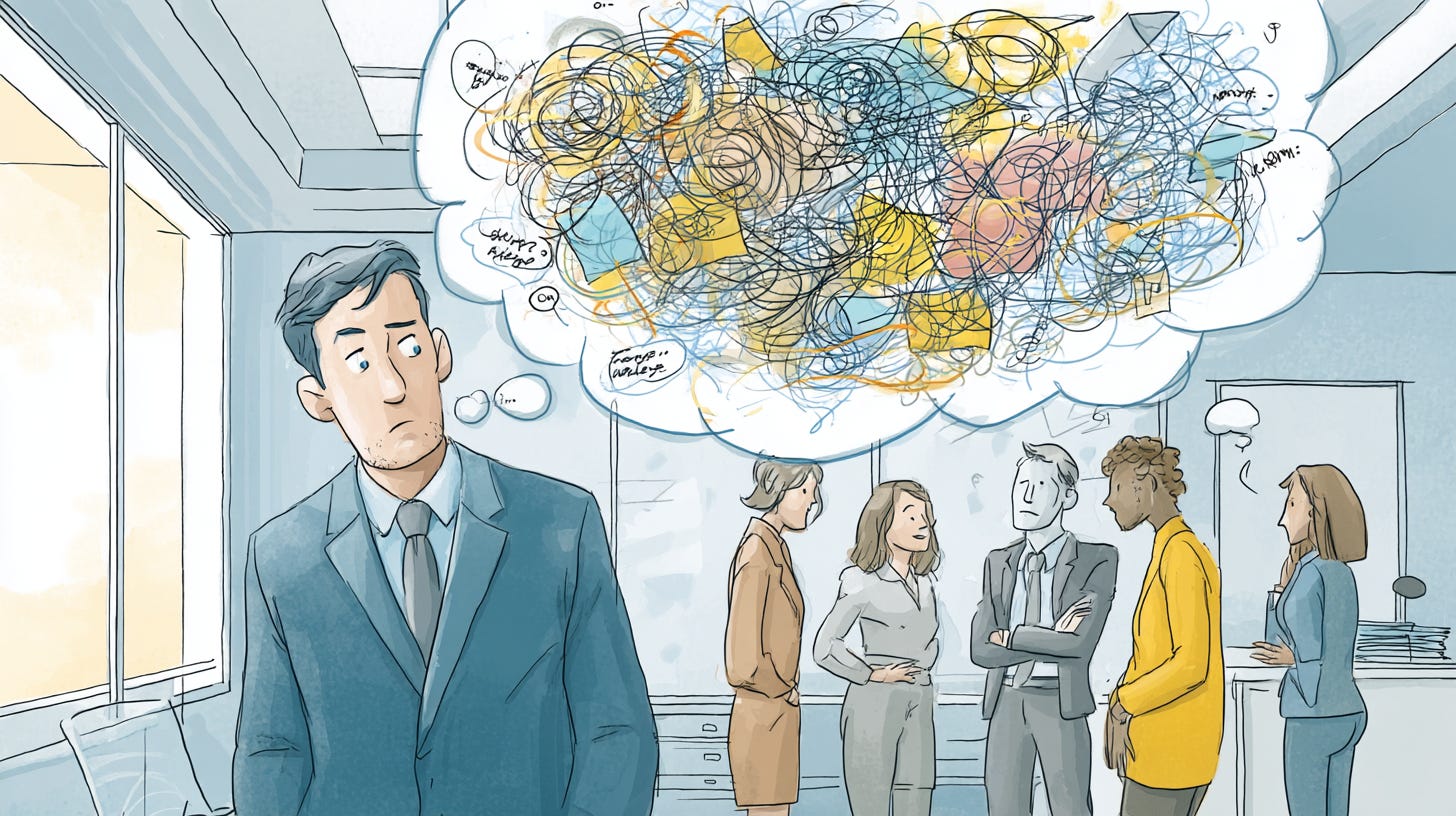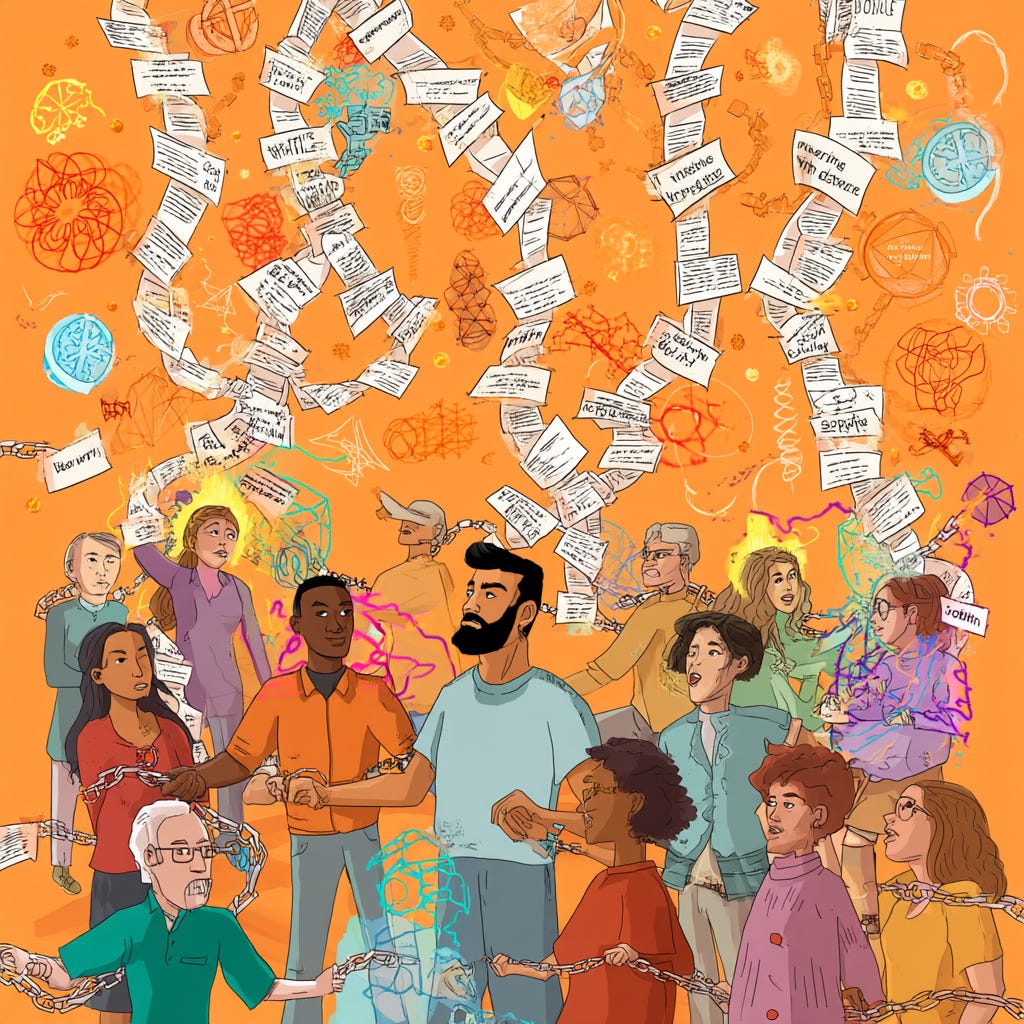Breaking the Cycle: Confronting Stigma and Dogma Around Neurodiversity
How outdated beliefs about 'normal' brains hold us all back, and what we can do about it—from the perspective of a 53-year-old leader newly diagnosed with ADHD
The Wake-Up Call That Changed Everything
At 52 fucking years old, I finally got my ADHD diagnosis. Let that sink in for a minute. For more than five decades, I'd been operating with a brain that was fundamentally different from what society considered "normal," without having the language, tools, or support to understand why.
The tidal wave of emotions that hit me after diagnosis was overwhelming – relief that finally there was an explanation for the constant noise in my head, grief for all the years spent wrestling with an unnamed challenge, and anger that it took so damn long for anyone to notice. As I wrote in my earlier article, old school reports from 45 years ago gutted me. Teachers' comments like "not living up to his potential" and "needs to apply himself more" screamed off every page once I had this new ADHD lens.
But here's the thing – my story isn't unique. Countless adults are discovering their neurodivergent identities later in life, after decades of being misunderstood, mislabeled, or flat-out dismissed. And this raises the question: Why the fuck are we still getting this so wrong?
From Classroom to Boardroom: How Stigma Takes Root
The stigma around neurodiversity doesn't magically appear in workplace policies or adult relationships. It's cultivated from childhood through misunderstandings, outdated educational approaches, and societal expectations that treat neurological differences as deficits rather than variations.

Think about standard classroom environments. They're designed for children who can:
Sit still for extended periods
Filter out background noise
Transition smoothly between activities
Manage emotions within narrowly accepted parameters
Follow sequential instructions without difficulty
Focus on topics regardless of personal interest
Sound like bullshit for a lot of kids? That's because it is. Research consistently shows that traditional educational environments are optimised for neurotypical minds and can be actively hostile to neurodivergent ones. A 2018 study found that ADHD children receive 23% more negative feedback than their neurotypical peers, even when exhibiting the same behaviours.
By reaching adulthood and entering the workforce, these early experiences have solidified into deep-seated beliefs about our capabilities, worth, and place in society. The child who was constantly told to "just focus" becomes the adult who believes they're fundamentally flawed or lazy when they struggle to complete certain tasks. The student punished for "disrupting class" becomes the employee who masks their authentic thinking style to avoid being labelled difficult.

I've spent my entire career in technology leadership learning to compensate for, hide, or apologise for my brain's natural operating system. The irony? Many qualities that make me effective as a leader—my creativity, ability to make unexpected connections, and hyperfocus on problems that capture my interest—are direct products of my ADHD brain.
The Dogma That Keeps Us Stuck

Let's talk about the bullshit beliefs that keep neurodiversity stigma firmly in place:
Myth #1: Neurodivergent conditions are rare exceptions rather than normal human variation
Reality check: Neurodiversity isn't some rare anomaly. Current research suggests that between 15% and 20% of the global population is neurodivergent in some way. That's one in five fucking people walking around with brains that process information differently than what's considered "standard."
Myth #2: Medication for ADHD (and other conditions) is just a crutch or way to avoid real effort
When I mentioned considering medication in one of my articles, I acknowledged the stigma with a simple "Fuck it." Because here's the truth: Telling someone with ADHD they shouldn't need medication is like telling someone with poor eyesight they should just squint harder instead of wearing glasses.
Studies consistently show that appropriate medication treatment for ADHD can improve quality of life, workplace performance, and relationship satisfaction. A landmark 2017 study in JAMA Psychiatry found that medication treatment was associated with a 32% reduction in motor vehicle crashes and a 58% reduction in substance use disorders.
Myth #3: Neurodivergent people need to adapt to neurotypical standards, not the other way around
For too long, the burden of adaptation has fallen entirely on neurodivergent individuals. We're expected to contort ourselves into neurotypical working patterns, communicating, and existing patterns, regardless of the personal cost.
But what if we flipped the script? Research from companies with robust neurodiversity hiring programs shows that accommodations for neurodivergent employees often create better working environments for everyone. Simple adjustments like providing agendas before meetings, offering noise-cancelling headphones, or allowing flexible work arrangements can dramatically increase productivity and well-being across the entire workforce.
Myth #4: Success means overcoming your neurodivergence
Perhaps the most insidious myth is that successful neurodivergent people have succeeded despite their neurodiversity rather than because of it. This framing treats neurodivergence as something to be minimised or hidden rather than potentially harnessed.
My ADHD brain's ability to fire "a million things a minute" has been incredibly valuable as a leader. It helps me provide vision and identify opportunities others might miss. As I wrote previously, "Recently, I identified an issue in our Digital Transformation process that I believe needs immediate attention. I'm building a coalition around this idea, showcasing how my ADHD-driven thinking can spark important initiatives."
Breaking the Cycle: What We Can All Do
So, how do we move forward? Here are some practical steps for creating environments where neurodiversity is recognised, respected, and leveraged for its unique strengths:
For Leaders:
Examine your own biases - If you find yourself thinking someone is "difficult," "too sensitive," or "not a team player," pause and consider whether you're encountering a different cognitive style rather than a personality flaw.
Create psychologically safe spaces - Make it clear through your words and actions that different thinking styles are welcome and valued. Simple statements like "I appreciate you bringing a different perspective to this discussion" can signal that cognitive diversity is an asset.
Review your hiring and promotion practices - Are you selecting for neurotypical social skills rather than actual job performance? Many neurodivergent individuals struggle with traditional interviews but excel at actual job tasks.
Model transparency - I've chosen to communicate openly with my team about my ADHD diagnosis. This transparency helps create an environment where others feel safe being their authentic selves.
Implement universal design principles - Rather than waiting for accommodation requests, proactively create environments that work for diverse neurological profiles. This includes clear communication, flexible work arrangements, and sensory-friendly spaces.
For Everyone:
Listen to learn, not to fix - When someone describes their neurodivergent experience, resist the urge to offer solutions or comparisons ("everyone gets distracted sometimes"). Just listen.
Check your language - Phrases like "Are you off your meds today?" or "That's so OCD" trivialise real neurological conditions and reinforce stigma.
Advocate for inclusive practices - Whether you're neurodivergent or neurotypical, speak up when you see policies or practices that exclude certain thinking styles.
Adjust your expectations around communication - Different neurological wiring often means different communication styles. Someone who interrupts may be managing working memory challenges, not being rude.
Educate yourself beyond stereotypes - Popular media often presents flattened, stereotypical versions of neurodivergent conditions. Seek out resources created by actually neurodivergent people.
The Future We Could Create
Imagine workplaces where different thinking styles are actively sought out and valued, where the hyperfocus of ADHD, the pattern recognition of dyslexia, the detail orientation of specific autism profiles, and the emotional intelligence of many with anxiety are all recognised as valuable parts of a cognitive ecosystem.
This isn't just feel-good inclusion talk – it's good business. Research from Harvard Business Review found that teams with neurodivergent members demonstrated superior problem-solving capabilities and innovation compared to homogeneous teams.
But more importantly, it's about creating a world where fewer people have to wait until their 50s to understand their minds, where children grow up knowing that their way of thinking is different, not deficient. The question isn't "What's wrong with you?" but rather "What unique perspective do you bring?"
As I continue to learn about my ADHD brain, I'm committed to using my leadership platform to challenge stigma and create more inclusive environments. Because the truth is, we don't just need to accommodate neurodiversity – we need to celebrate and harness it actively.
The squirrels in my brain might sometimes throw one hell of a rave, but they've also led me to insights, connections, and creative solutions that have defined my career. And I'm done apologising for them.
A Call to Action
If this resonates with you – whether you're neurodivergent yourself, suspect you might be, or simply want to create more inclusive environments – here's my challenge:
Start one conversation about neurodiversity in your workplace or personal life this week.
Question: Is one standard practice creating unnecessary barriers for different thinking styles?
Reach out to someone who thinks differently from you and genuinely try to understand their perspective.
Breaking through stigma and dogma isn't just about grand policy changes – these small, daily acts of understanding and inclusion. It's about recognising that the human brain isn't meant to be standardised, and our workplaces and communities are stronger when we embrace that fact.
Let's build a world where it doesn't take five decades to understand and appreciate our minds. That world would be more compassionate, innovative, creative, and successful by every meaningful measure.
Now, who's with me?




Good question. Spaces where I can be alone with myself other than sleep. Being outside or somewhere where there's a calm space that provokes thought. At the dining table. Having a day of nothing, watching where my thoughts travel to. Long car rides. Stop controlling the mind and let it imagine . I used to be able to do this alot as a teen when I was riding horses. Your article was brilliant. I wish articles such as this are spread around workplaces.
I thoroughly enjoyed reading this articke Daryl. Im.the same age as you and have struggled to slow down to be able to live in the deep, not on the surface. I have worked all my life, raised two beautiful boys into respectful young men yet I still feel exactly the same on the inside, but with layers to myself that make life feel like Im hearing myself speak under water. The number of impatient, arrogant work places are the norm and they have left a mark on me that has left little room for joy. If I think like a robot ie how we were trained in school, to not rock the boat, speak up or go against the invisible grain then I am seen as difficult. Hence the mask I need to wear. Its darn hard being a woman who has to work to feed her family, look after their needs which are first and foremost, yet be away from home more than what is healthy.
There's a long long way to go to change peoples lives for the better. The system is not designed to support people, its designed to make money. Not a fulfilling goal or feeling for many of us. Everyone wins when wellbeing is the focus, then hopefully society thrives too. To sum up, I dont believe our system supports healthy minds, toxicity is rampant. People like yourself are rare as hens teeth in the workplace.